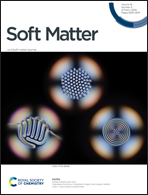Numerical simulations of vorticity banding of emulsions in shear flows
Abstract
Multiphase shear flows often show banded structures that affect the global behavior of complex fluids e.g. in microdevices. Here we investigate numerically the banding of emulsions, i.e. the formation of regions of high and low volume fractions, alternated in the vorticity direction and aligned with the flow (shear bands). These bands are associated with a decrease of the effective viscosity of the system. To understand the mechanism of experimentally observed banding, we have performed interface-resolved simulations of the two-fluid system. The experiments were performed starting with a random distribution of droplets, which under the applied shear, evolve in time resulting in a phase separation. To numerically reproduce this process, the banded structures are initialized in a narrow channel confined by two walls moving in opposite directions. We find that the initial banded distribution is stable when droplets are free to merge and unstable when coalescence is prevented. In this case, additionally, the effective viscosity of the system increases, resembling the rheological behavior of suspensions of deformable particles. Droplet coalescence, on the other hand, allows emulsions to reduce the total surface of the system and, hence, the energy dissipation associated with the deformation, which in turn reduces the effective viscosity.



 Please wait while we load your content...
Please wait while we load your content...